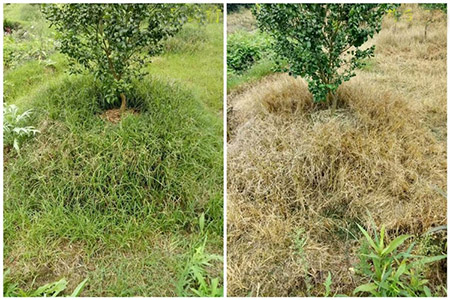The role of glyphosate
Background
Glyphosate, molecular formula C3H8NO5P, molecular weight 169.07 g mol-1, CAS number: 1071-83-6, melting point 184 ℃, decomposes at 187 ℃, easily soluble in water, insoluble in absolute ethanol, ether, benzene and other organic solvents. is an amphoteric compound[1]. The metabolite of glyphosate is Aminomethylphosphonic acid (AMPA), CAS number: 1066-51-9, molecular weight 111.04 g·mol−1
Glyphosate is a biocide herbicide developed by the famous American company Monsanto. Glyphosate is nephrotoxic, I haven't searched the relevant academic reports carefully, so I won't comment.), low residue, easy to be decomposed by microorganisms, does not damage the soil environment, and has the advantages of killing most plants. Later, thanks to the development and promotion of glyphosate-resistant genetically modified crops, this herbicide has been firmly sitting on the throne of the world's largest pesticide. Figure 1 shows a comparison diagram of glyphosate before and after use.

Figure 1 comparison diagram of glyphosate before and after use.
Glyphosate and GMOs
As a non-selective herbicide, glyphosate's mechanism of action is to competitively inhibit the activity of 5-enolpyruvate shikimate-3-phosphate synthase (EPSPS) in the shikimate pathway. EPSPS is shikimate-3 - Catalyst for the synthesis of 5-enolpyruvate-3-phosphoshikimic acid (EPSP) from phosphoric acid and phosphoenolpyruvate. EPSP is a key enzyme in the biosynthesis of aromatic amino acids (including tryptophan, tyrosine, and phenylalanine) in fungi, bacteria, algae and higher plants. Therefore, after treating plants with glyphosate, the synthesis of proteins containing these amino acids in plants is blocked, which in turn affects a series of metabolic processes, resulting in plant death. Glyphosate-resistant crops emerged after the discovery of the glyphosate-resistant gene. The first commercialized glyphosate-resistant crop was Roundup-Ready Soybean, a glyphosate-resistant soybean developed by Monsanto, first introduced in 1996. Planting in the United States.
Three aspects to improve the glyphosate resistance of crops
1. By overexpressing the enzyme inhibited by glyphosate, the plant can metabolize glyphosate normally after absorbing it. However, the glyphosate-resistant crops obtained by this method still show growth inhibition when exposed to glyphosate, which has not reached the level that can be commercialized.
2. Introduce EPSP with glyphosate affinity into the action, and quickly degrade glyphosate after it enters the plant. At present, this strategy has not been widely used in production.
3. Introduce a gene that degrades glyphosate, and successfully acquire resistance to glyphosate to EPSP, which is insensitive to herbicides through gene modification technology. . Insert a background knowledge here. Most of the enzymes in the organism are macromolecular substances composed of amino acids arranged in a certain order. They have a certain spatial structure and can be catalyzed by a specific enzyme. Structural sites combine to work. Changing the structure of the enzyme that glyphosate acts on can reduce or even eliminate the potency of glyphosate on that enzyme.
A range of bacteria contains EPSP that is resistant to glyphosate. Therefore, researchers have isolated glyphosate-resistant mutant genes from microorganisms such as Escherichia coli, Salmonella typhimurium and Agrobacterium tumefaciens. The CP4 gene isolated from the strain (A. tumefaciens sp. CP4). The glyphosate-resistant gene was introduced into soybean, and the CP4-EPSP synthase expressed in soybean plants was less sensitive to glyphosate, so that the shikimic acid pathway in transgenic plants could proceed normally. In this way, soybeans have shown resistance to glyphosate. Therefore, the first application of genetically modified food is glyphosate, which is to make crops exhibit pesticide-resistant properties, and then enable pesticides to achieve weeding and insecticidal effects.
Methods of Analysis for Glyphosate
Faced with the increasingly serious safety situation, countries will definitely increase the limit of glyphosate in food in the future and strengthen the monitoring of glyphosate in food, so it is imperative to improve the detection method of glyphosate residue in food. There are many test methods for glyphosate, such as chemical titration, such as potentiometric titration using lead nitrate or nickel nitrate to form a complex with glyphosate, and the reaction of glyphosate with bromine, using rhodamine as an indicator The limitation of chemical titration methods is that the detection limit is relatively high and it is not automated enough. But sometimes it's easy. In addition, there are immunoassays and molecular imprinting-chemiluminescence assays using antigenic responses, but these two methods are not widely used in the laboratory. At present, the most widely used method is chromatography, but due to the high polarity, small molecular weight, and no UV-absorbing groups of glyphosate, it is difficult to use gas-liquid phase analysis directly. Derivatization treatment is required before analysis. The current methods for analyzing glyphosate include ion chromatography, liquid chromatography, liquid mass, gas chromatography and other methods. Depending on whether derivatization is required, it can be divided into direct injection and derivatized injection methods. .
Reference
1 World Health Organization. Glyphosate[M]. World Health Organization, 1994.
Related articles And Qustion
See also
Lastest Price from Glyphosate manufacturers

US $100.00/KG2025-09-28
- CAS:
- 1071-83-6
- Min. Order:
- 1000KG
- Purity:
- 95%
- Supply Ability:
- 200tons/month

US $1.00/KG2025-09-14
- CAS:
- 1071-83-6
- Min. Order:
- 1KG
- Purity:
- 99%+
- Supply Ability:
- 2000 kgs


